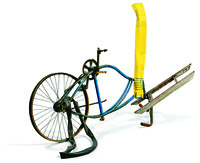« News, News World
Robert Rauschenberg: Gluts
Guggenheim Museum (Venice, Italy)
May 30 - September 20, 2009
A year after the death of Robert Rauschenberg, (May 12, 2008), the Peggy Guggenheim Collection, Venice, celebrates the memory of this great artist with the exhibition “Robert Rauschenberg: Gluts.” Comprised of approximately forty works, this exhibition, on view May 30 through September 20, 2009, presents a little-known body of Rauschenberg’s work in metal drawn from the holdings of the Rauschenberg Estate, with additional loans from institutions and private collections in the United States and abroad. Always one to recycle, Rauschenberg found new uses for what others tossed aside, reinvigorating detritus with a revealing second life. Faced with disparate objects littering his studio, he applied a direct approach to the Gluts (1986-89 and 1991-95), his final series of sculpture. For nearly a decade, Rauschenberg frequented the Gulf Iron and Metal Junkyard outside Fort Myers, Florida, near his home, gathering metal parts from traffic signs, exhaust pipes, radiator grills, metal awnings, and so on, which he incorporated into these poetic, humorous assemblages, where the whole becomes greater than the sum of its parts.
On the Gluts series, Susan Davidson, Senior Curator for Collections & Exhibitions at the Guggenheim Museum New York, relates that Rauschenberg’s artistic attention in the 1980s turned toward an exploration of the visual properties of metal. Whether assembling found metal objects or experimenting with his own photographic images screen-printed onto aluminum, stainless steel, bronze, brass, or copper, Rauschenberg sought to capture the reflective, textural, sculptural, and thematic possibilities of the material. Rauschenberg’s first body of work in this new material was the Gluts. The series was inspired by a visit to Houston on the occasion of “Robert Rauschenberg, Work from Four Series: A Sesquicentennial Exhibition” at the Contemporary Arts Museum. In the mid 1980s, the Texas economy was in the throes of a recession due to a glut (or surplus of supply) in the oil market. Rauschenberg took note of the economic devastation of the region, as he collected gas-station signs and deteriorated automotive and industrial parts littering the landscape.
Upon his return to his Captiva, Florida, studio, he transformed the scrap-metal detritus into wall reliefs and freestanding sculptures that recalled his earlier Combines. Rauschenberg chose these objects not only for their everydayness but also for their formal properties. Individually and collectively, materials such as these are the very foundation of his artistic vocabulary.
This exhibition is curated by Susan Davidson and by David White, curator for Robert Rauschenberg.
www.guggenheim-venice.it
Filed Under: News, News World



































